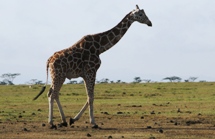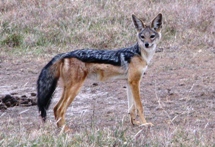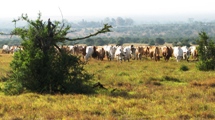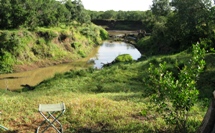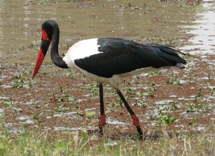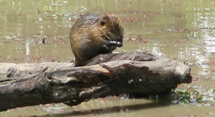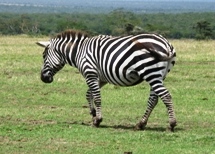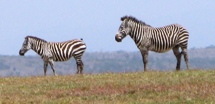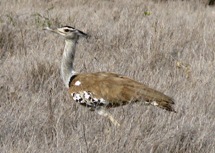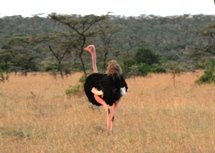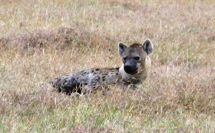Kenya : Day Four : Porini Rhino Camp
As our camp's name suggests, Ol Pejeta is noted for its rhino population, with (at the time of our visit) 86 black rhino living here, together with 10 white rhino (including 4 of the world's total population of only 8 Northern White Rhino). Our first game sighting, however, was of the reticulated giraffe, that is the only variety that is found in this area (![]() ), together with the rare Grevy's Zebra, whose stripe pattern is so much finer than that of the regular Plains Zebra (more of this later). Add to this a lithe looking black backed jackal (
), together with the rare Grevy's Zebra, whose stripe pattern is so much finer than that of the regular Plains Zebra (more of this later). Add to this a lithe looking black backed jackal (![]() ).
).
A particular treat was our first sighting of lions (![]() ), below, which are fairly elusive here, although there actually are three separate prides.
), below, which are fairly elusive here, although there actually are three separate prides.
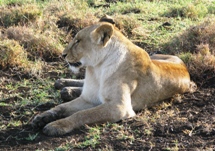
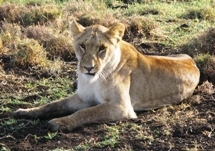
Not far away (from the lions, that is!) was another herd of domestic Maasai cattle (![]() ). Further on still, in an ideal spot on the banks of a small river, we discovered that a bush breakfast location had been set up for us (
). Further on still, in an ideal spot on the banks of a small river, we discovered that a bush breakfast location had been set up for us (![]() ). This spot was actually located close to a hippo hide, although there weren't any to be seen on this occasion.
). This spot was actually located close to a hippo hide, although there weren't any to be seen on this occasion.
We then drove to the Morani Information Centre, home to Baraka, a 17 year old blind black rhino (![]() ), below, who we were able to feed by hand from a viewing platform (
), below, who we were able to feed by hand from a viewing platform (![]() ), below.
), below.
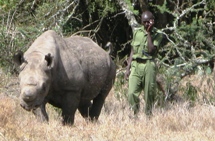
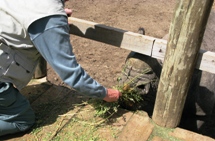
Numerous further sightings ensued, including warthog, elephant, zebra and giraffe. with a striking saddle-billed stork (![]() ), and, rather unexpectedly, a coypu (
), and, rather unexpectedly, a coypu (![]() ), also being observed. The saddle-billed stork seen here is a male, characterised by its black eye, the female having a yellow circle around the pupil. The way to remember the distinction is that the male once poked fun at how the female had made up her eye colour, whereupon she gave him a black eye!
), also being observed. The saddle-billed stork seen here is a male, characterised by its black eye, the female having a yellow circle around the pupil. The way to remember the distinction is that the male once poked fun at how the female had made up her eye colour, whereupon she gave him a black eye!
Most interesting of all, we were able to make the distinction between the common plains (Burchills) zebra (![]() ), opposite, and the much finer striped Grevy's zebra (
), opposite, and the much finer striped Grevy's zebra (![]() ), below left. However the remarakable thing is the presence of hybrid Plains/Grevy's zebra,(
), below left. However the remarakable thing is the presence of hybrid Plains/Grevy's zebra,(![]() ) below right. The situation is that it has always been well-known that the two species can't interbreed, but when the original four Grevy's zebra were moved into Ol Pejeta from the Lewa Conservancy, they were all males! But - hey! - what is a guy to do? So there are now numerous such hybrid zebra.
) below right. The situation is that it has always been well-known that the two species can't interbreed, but when the original four Grevy's zebra were moved into Ol Pejeta from the Lewa Conservancy, they were all males! But - hey! - what is a guy to do? So there are now numerous such hybrid zebra.
Their problem, however, is that their grazing and habitat requirements may turn out to be different to that of their parents. As a final comparison, consider the photo opposite (![]() ), that shows a Burchills zebra (left) posing next to a hybrid (right).
), that shows a Burchills zebra (left) posing next to a hybrid (right).
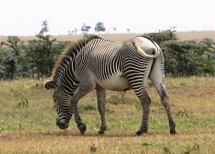
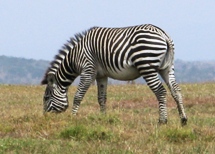
On our way back to camp we saw for the first time a Kori bustard (![]() ) (the world's biggest bird that is capable of flight), a Maasai ostrich (
) (the world's biggest bird that is capable of flight), a Maasai ostrich (![]() ) (that obviously isn't), a Jackson's Hartebeest, a Maasai giraffe and a hyena (
) (that obviously isn't), a Jackson's Hartebeest, a Maasai giraffe and a hyena (![]() ). On arrival in camp we were treated to a further Maasai spear-throwing demonstration, together with an exhibition of singing and dancing.
). On arrival in camp we were treated to a further Maasai spear-throwing demonstration, together with an exhibition of singing and dancing.
Before dusk we came across a large herd of giraffe (![]() ), below, close to a drinking pool, which made some remarkable silhouettes against the night sky as it got closer to dark (
), below, close to a drinking pool, which made some remarkable silhouettes against the night sky as it got closer to dark (![]() ), below.
), below.
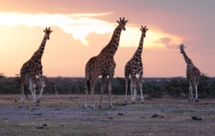
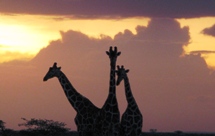
| Back to previous page (Day 3) | Forward to next page (Day 5) |
